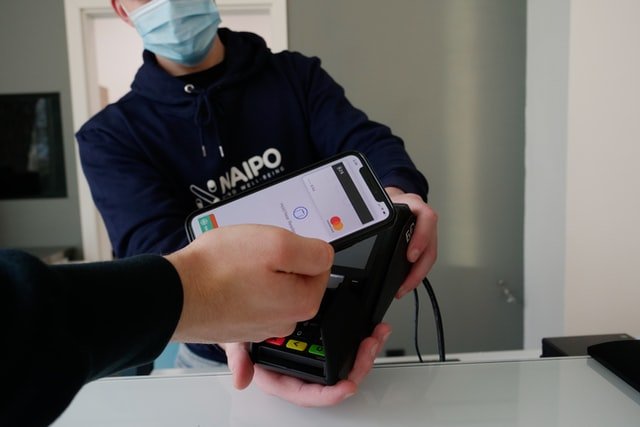Pay by phone

Pay by phone
About a dozen or so years ago, a payment card in a phone seemed like a far-fetched thing. Fortunately, the advancement of technology in the field of finance means that nowadays customers can pay for everyday purchases in different ways.
The mobile payment application is the main
If you already have an account and want to use it on mobile, check the banking apps ranking first. Thanks to him, you will learn about the possibilities that a particular application offers and the transactions that you can make with it.
As for the phone payment, depending on the method, it will be either an application of the bank itself (for example to use HCE or Blik) or an independent company ( Google Pay , Apple Pay ). Depending on the technology adopted, we can distinguish:
- Phone payments with NFC – Google Pay, Apple Pay, Contactless Card, Samsung Pay, HCE;
- Phone payments without NFC – Blik codes, checks and transfers to the phone.
Mobile payments with NFC
The first thing that comes to mind when we talk about phone payments is contactless transactions. If your smartphone has an NFC antenna, you can make this type of payment just as with “plastic”, that is, by installing the device in front of the terminal in the store. Let’s add that mobile payment will not always require running such a program on the device, but the phone itself should at least be woken up.
Google Pay
Google Pay is a payment method created by Google. A special mobile payment application is basically an electronic wallet to which you can attach a debit and credit card from selected banks. The service is based on HCE technology, which allows contactless payment by phone, just like with traditional “plastic”. The technical requirements for the application are Android version 4.4 and later and an active NFC module in the smartphone.
Google Pay is available to customers of Alior Bank, Bank Pekao, Bank Pocztowy, BNP Paribas, BOŚ Bank, Citibank (Mastercard), Credit Agricole, Getin Bank, ING Bank Śląski, mBank, Nest Bank, Noble Bank, Plus Bank, Santander Bank Poland ( Formerly BZ WBK), Spółdzielcza Grupa Bankowa and Toyota Bank, as well as cooperative banks of the BPS group.
- Almost. 8-9% of Poles pay with Google Pay online, and about 11% in stationary stores.
- For Google Pay to work, you need an app of the same name and an Android phone (minimum 4.4).
- We will pay for Google Pay both in stationary stores and in the online store, but also in mobile applications (eg Allegro, Pyszne.pl), although the availability of the service in individual electronic stores depends on the sellers.
Apple Pay
In addition to the above payments, Apple Pay is also popular in Poland, especially in the West. It’s a phone payment method for iPhone, iPad, Apple Watch, and MacBooks owners. Apple Pay appeared in Poland in June 2018 and is currently available in 17 banks.
You can add payment cards from cooperating banks to Apple Wallet and pay with them in both fixed stores and apps. Transactions are confirmed with a fingerprint (or by Face ID, if the phone has such a module), which increases the level of security.
- Almost. 6-10% of Poles pay with Apple Pay online, and about 8% in stationary stores.
- Apple Pay is available on iOS smartphones as well as other Apple devices.
- We’ll pay using Apple Pay wallet at fixed stores, online stores and mobile apps (eg Allegro and Wolt), and confirm the transaction with a fingerprint or a photo of the face.
HCE Contactless Payments
HCE (Host Card Emulation) payments are available on Android phones, at least. 4.4 The NFC module is on. The service allows contactless transactions with a smartphone, just like with a debit card – just unlock the device, install it in front of the payment terminal (or accept the transaction) and it’s ready.
The HCE payment service is available in many Polish banks: Bank Millennium, ING, PKO BP and some cooperative banks.
- About 8% of Poles use HCE payments at stationary stores.
- HCE requires a specific bank’s mobile application.
- HCE payments are only possible in traditional stores.
Samsung Pay
In the global banking market, you can also meet Samsung service, such as Samsung Pay . Unfortunately, this system is not available in our country and so far there is no indication that anything will change in the near future. Samsung Pay representatives note that our market is quite saturated with various other forms of mobile payments, so implementing another method may simply not pay off, but recently they have been investigating customer expectations of this transaction payment system.
What’s new in the aforementioned mobile payments? It works similarly to Google Pay and Apple Pay – you can add payment and loyalty cards to it and pay by phone, just like with traditional “plastic”. However, Samsung Pay has one advantage over the competition; The MST (Magnetic Secure Transfer) technology used here allows transactions at terminals that support magnetic stripe cards. Thanks to this, we can pay with the phone on devices that do not support contactless payments! Unfortunately, this option is only available on the latest Samsung models that support MST technology.
How to pay by phone without NFC?
However, there are cases when contactless payment by phone will not be possible, whether due to technical problems or due to a device that does not have an NFC antenna. Fortunately, in such cases, we can still pay by mobile phone, although it will be less convenient. We mean Blik and the opportunities it offers to its users.
Blik . Mobile Payments
Blik is based on one-time codes generated in the bank’s mobile application, but it also provides contactless payments over the phone. With this code, we can pay in a stationary store, on the Internet, as well as withdraw cash from ATMs. Blik’s unique service is also transfers to phone and checks.
Blik is a nationwide mobile payment system. The project is the work of Polski Standard Płatności, whose contributors are Alior Bank, Bank Millennium, ING Bank Śląski, mBank, PKO BP (including Inteligo) and Santander Bank Polska (formerly BZ WBK); The system is serviced by the National Clearing House. BLIK has been operating since February 9, 2015, in 2016 it joined the system Getin Bank and T-Mobile Usługi Bankowe (now no longer in existence), in 2017 by BNP Paribas, in 2018 the service was provided by Credit Agricole and Bank Pekao SA. and in 2019 – Spółdzielcza Grupa Bankowa. The years 2020 and 2021 are the following banks in Blik: Nest Bank, BPS Group, Bank Pocztowy, Bank Spółdzielczy in Brodnica, Bank Pocztowy, BOŚ Bank and Citi Handlowy.
- Almost. 26-27% of Poles pay with Blik online, and about 18% in stationary stores.
- Blik is based on 6-digit codes and is closely related to the mobile application of a particular bank.
- With Blik, we can pay in stationary stores, online stores and mobile applications, download money from ATMs, but also send money to a friend.
Transfer to the phone
Most of us, when considering telephone transactions, associate it with a contactless function, and at the same time, this is not the only option for making payments. It happens that we want to settle accounts with friends for joint expenses, and we can not do this without contact. Then Blik comes to our aid, more precisely, the transfer to the phone. The service is intuitive and simple – instead of the account number, we enter the recipient’s phone number into the bank application and … that’s it. The money reaches the addressee within minutes.
PeoPay for Pekao Bank customers
A few years ago, we included PeoPay as a separate mobile payment method, only for Pekao Bank customers. In the application of the same name, it was possible to pay in stationary and online stores, withdraw cash from Pekao Bank ATMs and send money to other PeoPay users. Contactless payments in PeoPay were based on HCE technology. Currently, the bank is no longer developing this functionality and is offering customers to add a card to Google Pay or Apple Pay directly via PeoPay. Interestingly, though, you don’t need a payment card! You can add PeoPay (with a personal connected account) to your digital wallet and make contactless payments.
The prerequisite for using PeoPay is to have a personal Pekao SA account. An additional and unique function is the possibility of making phone transactions in foreign currencies (thanks to the option of multiple currencies).
Telephone payments and security
Today, the answer to the question of how to pay by phone in a store is no longer a problem, but bank customers may have doubts about the security of such transactions. It is not without foundation, it is easy to imagine that someone steals our smartphone and carelessly pays it. For this reason, it is worth taking care of updating the application on the phone and complying with the requirements established by certain payment regulations, for example, setting a screen lock, etc. In the case of contactless payments using a smartphone, it is also a good idea to check whether the NFC module can be turned on when the device is locked (from the “top level”). beam “) – if this is the case, then it is worth adjusting the settings so that this is impossible.
Phone payments are popular
Today, everyone has a phone with them and it happens that it is easier for us to forget about money than a smartphone. Mobile devices make our lives easier, so it should come as no surprise that banks are also beginning to offer their services via these carriers, thanks to traditional card payments gaining stiff competition. Modern phones nowadays allow you to pay not only in apps, but also contactless, just like with a debit or credit card.
Banks are still developing their own payment solutions – today HCE is a thing of the past, and customers are using modern Google Pay, Blik and even Apple Pay payments. The Polish market for mobile banking is one of the most modern in the world and only time will tell which payment methods we will continue to use.



